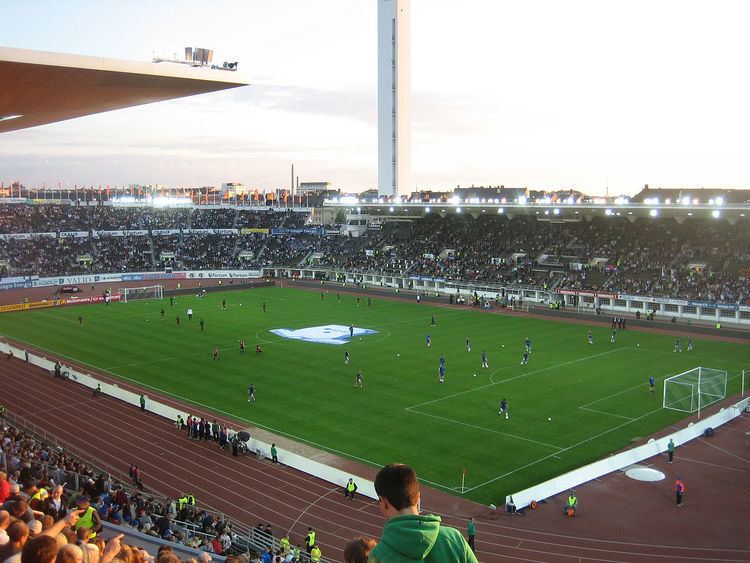Sport Bandy Countries Worldwide | Inaugural season 1957 | |
 | ||
No. of teams 18 (last tournament, 2017) Most titles Soviet Union (14 titles) | ||
The Bandy World Championship is a competition between bandy-playing nations. The tournament is administrated by the Federation of International Bandy. It is distinct from the Bandy World Cup, a club competition.
Contents
History
Although bandy has been played since the 19th century, the first men's world championships were only played in 1957, and the first women's ones were only in 2004. A bandy tournament was held as a demonstration sport at the 1952 Winter Olympics in Oslo, but this had no world championship status. A four nation tournament in 1954 was played in Moscow, this was the first time the Soviet Union met teams from other countries and the first time the new, jointly agreed rules were used, but this wasn't called a world championship. The international federation was founded in 1955 by the four countries which had played in Moscow.
The first ever Bandy World Championship was organised in 1957 in association with the 50th anniversary of the Ball Association of Finland, which at the time was the governing body of bandy in Finland. It was played at the Helsinki Olympic Stadium.
From 1961-2003, the men's championships were played every two years, but has since then been played annually.
Participating nations
For a long time, only four countries competed in the world championships: the Soviet Union, Sweden, Finland and Norway, with the Soviet Union as the dominating country. Since then, more countries have joined the tournaments, starting with the United States in 1985. The interest for the sport has spread to other parts of Europe, North America and Asia, and the dissolution of the Soviet Union in 1991 also opened the way for separate national teams from the former states of that union. Somalia became the first team from Africa to compete, in the 2014 tournament in Irkutsk. The record number of participants are 18, set in 2016 and 2017.
Denmark, Switzerland, Armenia and Poland are countries that have expressed interest in participating in future tournaments, but has so far (2017) not made any appearance. Denmark and Poland have in fact exited FIB. Armenia wanted to come already to 2011, but wasn't allowed to, as the tournament format at the time only allowed twelve teams and several more wanted to come. Of the countries which still haven't taken part, at least India was also denied in 2011. Most probably also Lithuania. The reason for the 2011 tournament having only eleven teams, was a late cancellation from Australia, another country no longer an FIB member.
With more nations competing, Group B was created in 1991. In 2012 there was a Group C for the first time as 14 countries participated. Group C was abolished already in 2013, when instead two sub-groups of Group B were created. In 2014 there were two sub-groups also in Group A, increasing the number of teams in that division from six to eight. The number of groups is not fixed, it is changed from year to year. Japan and Kyrgyzstan made their first World Championships in 2012, Ukraine joined in 2013, Germany and Somalia made their debuts in 2014 and China in 2015. Russia, Finland, Sweden, Kazakhstan, Norway, USA and Belarus usually play in group A. Until 2011, the best team in group B used to go into a playoff match with the team which came bottom of the A-group, replacing them if they won. In 2004 the B-pool was played in a location separate from group A for the first time, at the City Park Ice Rink in Budapest. In 2013 this happened again as Vetlanda hosted the B-pool, whereas Vänersborg was the main venue of the A-pool with three matches played at other locations, Trollhättan, Gothenburg and Oslo. In 2015 and 2016 the tournament were separated in time while in the same cities. The Division B matches are shorter in time, except for the end matches.
Participating teams
G = gold, S = silver, B = bronze, X = took part, but won no medal, D = disqualified
Competition format
Originally, the competition was played as an all-meet-all round-robin tournament. Starting in 1983, semifinals and a final was added to follow the round-robin stage.
When the number of participating nations increased, the championship was split up in two groups from 2003 onwards, A and B, with the better teams in Group A. The winner of Group B will typically play a game against the least successful team of Group A to determine qualification for Group A for next year.
TV broadcasting
The interest is biggest in Sweden, Finland and Russia. For a few times now it has been shown on Eurosport 2.
Medal table
Countries in italics no longer compete at the World Championships.
